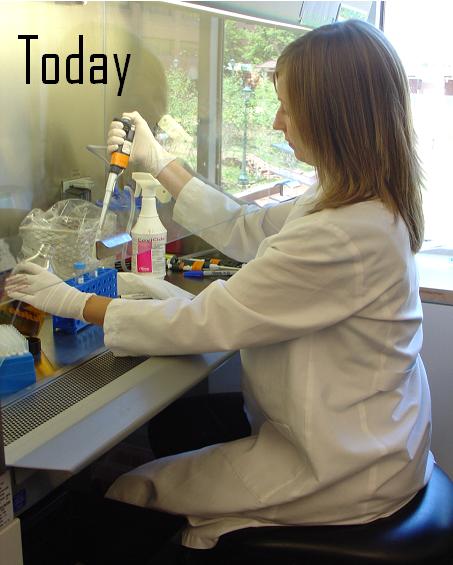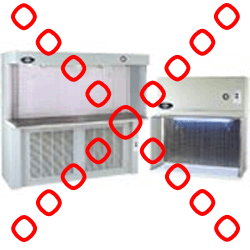Biological Safety Cabinets and other primary containment devices are an essential component of conducting biomedical research. As a primary safety barrier, the effectiveness of the Biological Safety Cabinet (BSC) is limited by the techniques employed by the researcher (e.g. good microbiological techniques), an understanding of how the cabinet functions, and the location of the biological safety cabinet within the facility. As a general rule, keep biosafety cabinets away from doors, high traffic areas and supply diffusers. EHS Biosafety can provide consultation and guidance on the selection, operation and use that meet your specific research needs.
BSCs are required to be certified annually or when moved or repaired. EHS Biosafety provides a centralized system to reduce cost, and improve service to the research community.
If you have any questions about the changes in the program or if you discover that your cabinet is past due for its annual certification, contact Jennifer Kershner at jmw4qs@virginia.edu or 434.982.4911.
Surplus Property - Procedure to surplus a cabinet
All testing and certification services for research and clinical laboratories will be provided by Precision Air, Inc. EHS will work with Precision Air, Inc. to ensure that all biosafety cabinets at the medical center or on grounds are certified annually and maintained in safe working condition. Additionally, a second vendor, JP Certifications, will provide certification services exclusively for the Center for Comparative Medicine and areas within the main hospital (i.e., Pharmacy, Clinical Lab, etc.).
Who schedules certifications? EHS maintains a centralized database of all BSCs at UVA. The database is used by EHS to coordinate annual certification of BSCs with the appropriate vendor prior to the BSC recertification due date. Vendors are instructed to schedule BSC recertification with laboratory personnel within the month that the certification is due; however, laboratory personnel are ultimately responsible for ensuring that BSCs are certified prior to expiration. Please contact EHS (434.982.4911) if you would like to verify that a vendor has been scheduled to recertify your BSC.
For emergency calls (including repairs) any of the eligible vendors may be contacted. There are several important facts to consider:
What is covered? Testing and certification services are paid for by EHS through a research overhead account. At the completion of services, vendors will submit an invoice directly to EHS for processing and payment.
*NEW* Gas Decontamination Services for lab moves/relocations. To better ensure when gas decontamination is necessary to safely move or relocate a BSC, EHS will cover this cost for research labs. Please consult with EHS to determine if a gas decon is necessary.
Note: gas decontamination for repairs and other services including HEPA filter changes are not covered (see below).
Non-research organizations (i.e., hospital and non-research clinical departments) are back-charged through Oracle cost transfer.
Note: Clinical departments still benefit indirectly by obtaining competitive, bulk service rates.
What is not covered? Repairs, expendable parts (e.g. HEPA filter changes, motors, light tubes, etc.), and labor charges. If a gas decon is necessary for repairs or a HEPA filter change, the lab must cover this cost. These may also be back-charged by Oracle cost transfer, however vendors may request a PTAO up front for services not covered.
UVA Environmental Health & Safety
Contact: Jenni Kershner
Email (preferred): jmw4qs@virginia.edu
Office Phone: (434) 982-4989
Cell Phone: (434) 531-2898
Technician: Dwight Smith (NSF certified)
Precision Air Technology, Inc.
Contact: Jeff Anderson
Email (preferred): jeff@precisionairtechnology.com
Phone: (919) 812-5168
Alternate Contact: Kevin Heathcock
Email: kevin@precisionairtechnology.com
Phone: (919) 369-5564
P.O. Box 46449
Raleigh, NC 27620
Fax: (801) 740-3346
JP Certifications, Inc.
Contact: Joe Martz
Email (preferred): joemartz123@gmail.com
Phone: (703) 620-3325
Fax: (703) 620-4765
11921 Waples Mill Road
Oakton, VA 22124
(*Pharmacy, Hospital Clinical Laboratory, Labs/Clinics within main hospital building)
JP Certifications, Inc.
Contact: Joe Martz
Email (preferred): joemartz123@gmail.com
Phone: (703) 620-3325
Fax: (703) 620-4765
11921 Waples Mill Road
Oakton, VA 22124
(*Pharmacy, Hospital Clinical Laboratory, Labs/Clinics within main hospital building)
Precision Air Technology, Inc.
Contact: Jeff Anderson
Email (preferred): jeff@precisionairtechnology.com
Phone: (919) 812-5168
Alternate Contact: Kevin Heathcock
Email: kevin@precisionairtechnology.com
Phone: (919) 369-5564
P.O. Box 46449
Raleigh, NC 27620
Fax: (801) 740-3346
Who do I contact about getting a BSC? Contact University of Virginia Procurement Services to determine pricing with UVA contract vendors or select an individual BSC manufacturer.
More information can be found by searching under Lab Equip/Supplies/Services - Lab Casework, Fume Hoods & Accessories
What type of BSC do I need? The type of BSC needed is determined by the type of material that you wish to use in the BSC. Contact EHS (434.982.4911) if you are unsure about the type of BSC you need.
A Class II, A2 Biosafety Cabinet is recommended and the most common type of BSC in use, as it is appropriate for most biohazardous work applications. Class II BSC provide personnel protection from biohazardous materials using HEPA filtered air prior to release into the room, in addition to providing product protection (to maintain sterility). Information on specific classes and types of Biosafety Cabinets can be found in the BMBL published by the CDC.


Should my Class II A2 BSC be thimble connected to the building exhaust system? For most applications, it is not necessary to connect a Class II A2 BSC to the building ventilation system. Class II A2 cabinets are designed to be “convertible” units and can be connected to the ventilation system using a thimble connection designed with an air gap. This is recommended only in certain situations that merit connection to the HVAC system. Contact EHS (434.982.4911) and Facilities Management before having any BSC connected (or disconnected) to the building exhaust system.
Are the UV lights in my BSC effective as a secondary disinfectant? Ultraviolet (UV) lamps are not recommended in BSCs nor are they necessary. If installed, UV lamps must be cleaned weekly to remove any dust and dirt that may block the germicidal effectiveness of the ultraviolet light. The lamps should be checked weekly with a UV meter to ensure that the appropriate intensity of UV light is being emitted. UV lamps must be turned off when the room is occupied to protect eyes and skin from UV exposure, which can burn the cornea and cause skin cancer. If the cabinet has a sliding sash, close the sash when operating the UV lamp.
Reference: BMBL published by the CDC.
Can I use a clean bench for biohazardous work? Laminar Flow Cabinets, sometimes referred to as Clean Benches, may be used for work with materials that are non-infectious. No infectious work (human cell lines, infectious microorganisms, toxins, or animal work) should be performed in Laminar Flow Cabinets. They are not recommended as they provide only product protection, and in effect, blow air from the cabinet into the user’s face providing no personnel protection.

Should my BSC be hard ducted or thimble connected to the building exhaust system? For most applications, it is not necessary to connect a BSC to the building ventilation system. However, certain types of Class II cabinetry require a hard-duct connection to the building ventilation system. These include Class II Type B1 and B2 cabinets and are only recommended in specific situations involving the use of certain volatile chemicals or radioactive materials. Contact EHS (434.982.4911) for information on when a hard-ducted cabinet is necessary.
Class II A2 cabinets are designed to be "convertible" units and can be connected to the ventilation system using a thimble connection designed with an air gap. This is recommended only in certain situations that merit connection to the HVAC system. Contact EHS (434.982.4911) and Facilities Management before having any BSC connected to the building exhaust system.
Note: In most cases, a recirculating Class II A2 cabinet is the most appropriate choice for UVA researchers.
Why must my BSC be certified? BSC are the primary containment device used to protect the worker, product and environment from exposure to biohazardous agents. The accepted standard is the NSF 49, which overall, serves to validate the design, operation, and testing of biological safety cabinets. The purpose of testing and certification is to ensure the balance of inflow and exhaust air, the distribution of air onto the work surface, and the integrity of the cabinet1.
How often must my BSC be certified? BSC must be certified at the time of installation and annually thereafter. The BSC must be re-certified after it has been moved or when repaired (e.g., HEPA filter replacement).
How do I get my BSC certified? UVA provides an in-house program through EHS, as well as contracts with outside vendors for testing and certification services. For more information (see above).
Note: Units with certification stickers may display an outdated or incorrect vendor contact. Information (listed above) should be used to contact a vendor.
What if I need to get my BSC repaired? Contact any of the eligible vendors (listed above).
Does my BSC need to be decontaminated? Contact any of the eligible BSC vendors (listed above) to decontaminate the BSC and perform decontamination of all work surfaces with an appropriate disinfectant before servicing. Remove all equipment, sharps and waste from the BSC.
How do I get my BSC gas decontaminated? Decontamination of the BSC using a gas decontamination method (e.g., para-formaldehyde gas or hydrogen peroxide vapor) may be necessary based on the agents used.
You should first contact EHS for a risk assessment, followed by contacting the BSC vendor for service. Prior to vendor servicing, perform surface decontamination of all work surfaces (including grilles, drain pan, inside of sash, etc.) with an appropriate chemical disinfectant. Remove all equipment, sharps and waste from the BSC.
What if I need to move my BSC? Or dispose of it? In many cases, the BSC must be gas decontaminated prior to being moved, stored, or disposed of in order to protect personnel from any potential exposure to biohazardous materials.
Contact any of the eligible BSC vendors (listed above) for decontamination service.
Once decontaminated, EHS will certify that the unit is ready to be moved and will provide the lab with a sticker indicating that the BSC is safe to move.
Contact Facilities Management to move the unit once it has been cleared by EHS. If moving to a new location, the BSC must be re-certified in the new location prior to use.
Instructions on the proper use of the Biological Safety Cabinet (BSC)
Biological Safety Cabinets (BSC) must be certified annually and whenever moved. BSC are certified by an in-house or outside contractor at no cost to the Principal Investigator. EHS Biosafety provides a list of designated, NSF-certified vendors from which to choose. Laboratory staff are responsible for coordinating BSC certification service directly with EHS or the vendor.